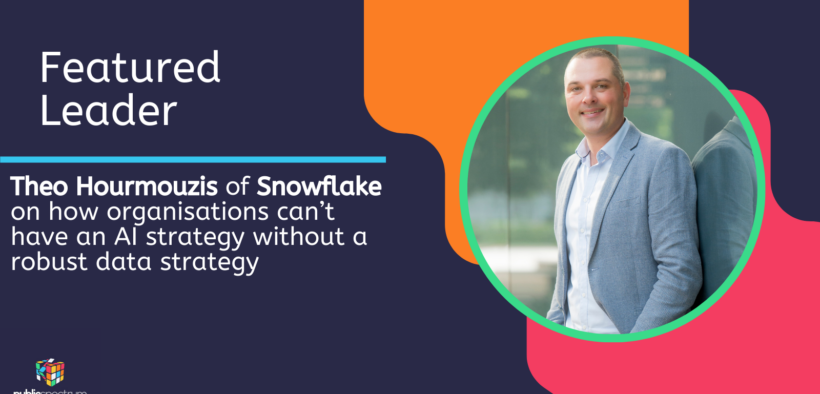Theo Hourmouzis on how organisations can’t have an AI strategy without a robust data strategy
Share

In today’s fast-paced digital era, it is key for organisations to have a strong data strategy in place when implementing an AI strategy. The growing dependence on AI for decision-making and strategic planning highlights the importance of precise, dependable data. Nevertheless, the present situation presents considerable obstacles, such as concerns about data privacy, problems with data quality, and the requirement for proficient data analysts.
Public Spectrum has caught up with Theo Hourmouzis, Vice President for Australia and New Zealand at Snowflake, who has extensive experience in addressing this important matter. Hourmouzis’ extensive experience in data management and AI implementation uniquely positions him to offer valuable insights into this pressing issue.
Hourmouzis, a seasoned expert in the field, has a proven track record of helping organisations navigate the complexities of data management. He has extensive experience in multiple industries and has played a key role in encouraging organisations to embrace AI technologies by fostering a data-centric culture.
Theo Hourmouzis discusses the importance of a strong data strategy for organisations looking to develop an AI strategy.
1. How can a strong data strategy support a successful AI strategy in organisations?
There is no AI strategy without a data strategy. The first thing to understand about AI is that it is entirely dependent on the data upon which it is fed. Generative AI (GenAI) and Large Language Models (LLMs) may seem sentient, but they aren’t capable of thinking or reasoning. What they do, and they can do it extremely well, is find patterns in data and predict what should come next.
This predictive capability is based on the data it has access to. If that data is incomplete or managed incorrectly, then the results AI delivers cannot be trusted. Not only is there the risk of hallucinations when it provides incorrect analysis of the data, but there is also the possibility of sensitive or personally identifiable information being exposed.
2. What are some common mistakes that companies make when they attempt AI initiatives without data?
In the rush to AI, there are three common pitfalls I see organisations make: overlooking the governance, quality, and completeness of the data being fed into an AI model.
Data governance is critical to any successful AI initiative. One of the major benefits of AI is that it promises to democratise data access, but this brings with it the risk of sensitive data leakage. Having guardrails around your data, like role-based access controls (limiting access based on the seniority, department, or function of each employee), data masking (obfuscating personally identifiable information), or data clean rooms (allowing collaboration without disclosing raw data), can greatly mitigate this risk.
Data quality cannot be overlooked in an AI strategy. If the quality of the data being fed into a model is out-of-date, miscategorised, or otherwise incorrect, then no results can be trusted. In other words, ‘rubbish in, rubbish out’.
Having a complete view of an organisation’s data ensures any answers delivered by AI are made in complete context. Organisations typically have myriad data silos and sources; in the public sector, for example, this data dispersal is pronounced due to the number of agencies, departments, and ministerial offices. These need to be collapsed and brought to a central location to ensure AI has a complete view of the organisation. Further, once data is stored in a central location, ensuring governance and quality becomes much easier as policies can be implemented and managed centrally.
3. Based on your expertise, what are the key components of a successful data strategy for AI?
The most critical component of a successful data strategy is centralising data within a single data platform. This breaks down the silos that exist within an organisation and makes the challenges of implementing AI much easier to manage.
When data is all centrally located, governance policies can be implemented and managed universally, ensuring there are no gaps. Additionally, security measures such as role-based access controls and data masking for personally identifiable information are much easier to maintain.
Another benefit is that it accelerates AI innovation within the business. Rather than the traditional model of bringing data to the AI application and repeating this process for each use case, this approach allows the business to bring the app to the data.
As that data is readily available, governance is already assured, and security measures have already been implemented, innovation isn’t impeded.
4. How can Snowflake assist businesses in building a data strategy for advanced AI?
By bringing all an organisation’s data together within Snowflake’s AI data cloud, data silos are eliminated and architectures are simplified. This enables value to be extracted from data much quicker.
Further, once data has been centralised, we provide seamless access to AI and Machine Learning via the Snowflake Platform, the Snowflake Marketplace, and our partners. This radically simplifies the process of innovating with AI, as pre-built models and applications can be deployed with just a few clicks. Earlier this month, we also announced Snowflake Arctic, a powerful enterprise-focused LLM organisation that organisations can use to develop their own conversational copilots and chatbots. It will be available through Snowflake Cortex, a fully managed service that offers machine learning and AI solutions to Snowflake users. These features are currently available in some regions and are being rolled out to most customers across the globe over time.
5. What future trends do you see at the convergence of data management and AI?
The biggest trend I see emerging is the democratisation of data across organisations. In days gone by, data scientists and analysts had complete dominion over how an organisation’s data would be used, and typically only they had the training and know-how to use it.
But as data becomes accessible and AI applications are made available in the same way you’d download an app on your phone, suddenly the barrier to entry is much, much lower.
This will enable non-technical employees—say someone in marketing, HR, or even those at the executive level—to very easily spin up their own AI to extract the insights they need.
The first step towards this shift is bedding down the data strategy and ensuring non-negotiables like governance and security blanket all your data. Once this has been put in place, the possibilities are endless.

Justin Lavadia is a content producer and editor at Public Spectrum with a diverse writing background spanning various niches and formats. With a wealth of experience, he brings clarity and concise communication to digital content. His expertise lies in crafting engaging content and delivering impactful narratives that resonate with readers.


Today’s Pick
11th Annual Aus Goverment Data Summit
April 1, 2025
7th Annual NZ Government Data Summit
May 7, 2025
3rd Public Sector Comms Week
May 14, 2025
Subscribe
We send emails,
but we do not spam
Join our mailing list to be on the front lines of healthcare , get exclusive content, and promos.
AI appointment Australia Australian boost boosts business businesses covid-19 cyber cyber attack cybersecurity cyber security data data breach data management defence Digital employment enhance enhances fraud funding governance government grants infrastructure Innovation Lockdown management new zealand NSW NZ online privacy public Public Sector queensland renewable energy scams security Social Media Technology telecommunications victoria
-

Understanding and building your digital strategy
Digital Government, Opinion
-

Featured Leader: Jamie Morse on multi-channel strategies for communication
Communications, Featured Leader
-

Featured Leader: Tegan Tembe of NSW Treasury on creating solid planning strategies and processes
Featured Leader
-

Wirraka Maya Health Service improves patient care with My Health Record
Learning
Show More-

Effects of ineffective communication in the workplace
Communications, Personal Development
-

7 ways you can enhance your personal development skills
News, Personal Development
-

5 advantages of working in the public sector
News, Personal Development, Professional Development
-

7 causes of communication issues in the workplace
Communications, News, Personal Development
Show MoreLast Viewed